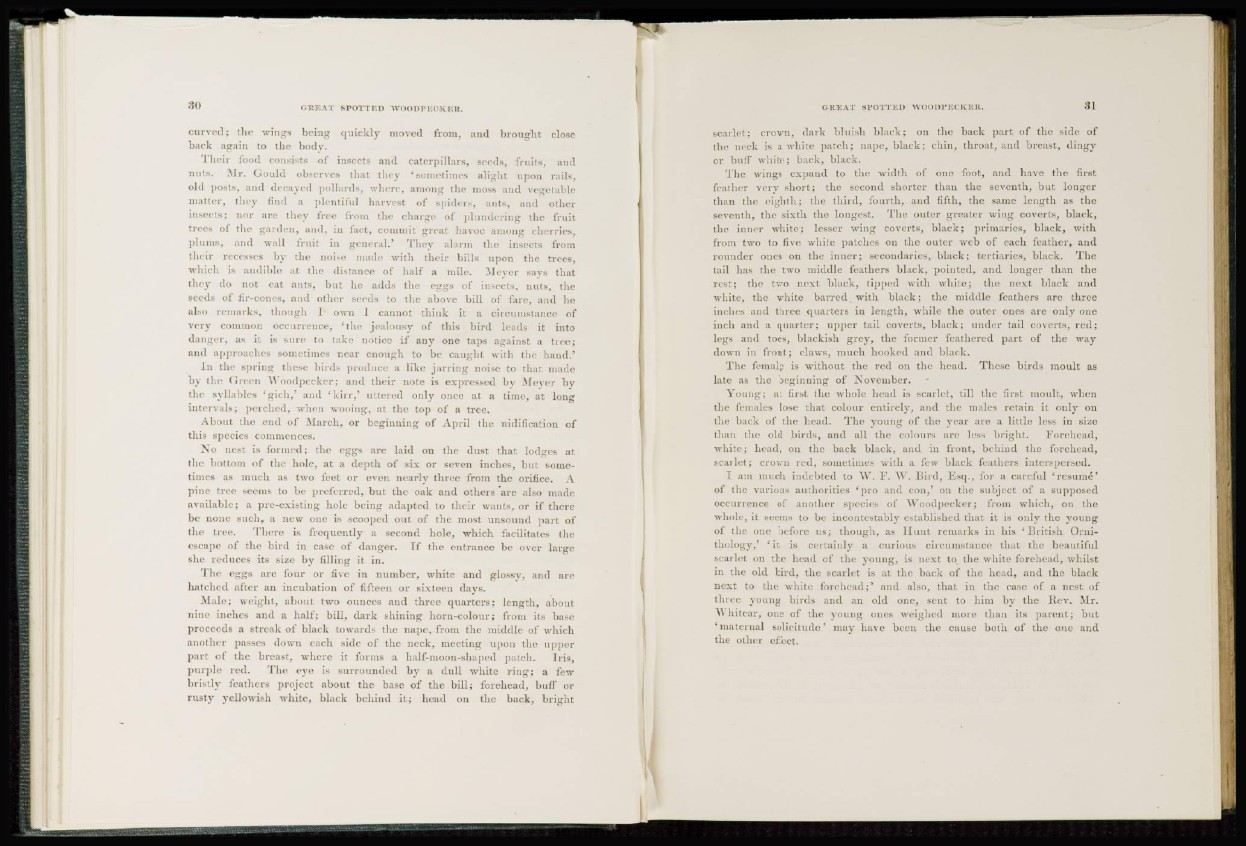
curved; the -wings being quickly moved from, and brought close
back again to the bod v.
Their food consists of insects and caterpillars, seeds, fruits, and
m i l s . Mr. Gould observes that they 'sometimes alight upon rails,
old posts, and decayed pollards, where, among the moss and vegetable
matter, they find a plentiful harvest of spiders, ants, and other
insects; nor are they free from the charge of plundering the fruit
trees of the garden, and, in fact, commit great havoc among cherries,
plums, and wall fruit in general.' They alarm the insects from
their recesses by the noise made with their bills upon the trees,
which is audible at the distance of half a mile. Meyer savs that
they do not eat ants, but he adds the eggs of insects, nuts, the
seeds of fir-cones, and other seeds to the above bill of fare, and he
also remarks, though I own 1 cannot think it a circumstance of
very common occurrence, 'the jealousy of this bird leads it into
danger, as it is sure to take notice if any one taps against a tree;
and approaches sometimes near enough to be caught with the hand.'
In the spring these birds produce a like jarring noise to that made
by the Green Woodpecker; and their note is expressed by Meyer by
the syllables (gich,' and 'kirr,' uttered only once at a time, at long
intervals; perched, when wooing, at the top of a tree.
About the end of March, or beginning of April the nidin*cation of
this species commences.
No nest is formed; the eggs are laid on the dust that lodges at
the bottom of the hole, at a depth of six or seven inches, but sometimes
as much as two feet or even nearly three from the orifice. A
pine tree seems to be preferred, but the oak and others are also made
available; a pre-existing hole being adapted to their wants, or if there
be none such, a new one is scooped out of the most \insound part of
the tree. There is frequently a second hole, which facilitates the
escape id' the bird in case of danger. Tf the entrance be over large
she reduces its size by filling it in.
The eggs arc four or five in number, white and glossy, and are
hatched after an incubation of fifteen or sixteen days.
Male; weight, about two ounces and three quarters; length, about
nine inches and a half; bill, dark shining horn-colour; from its base
proceeds a streak of black towards the nape, from the middle of which
another pas>es down each side of the neck, meeting upon the upper
part of the breast, where it forms a half-moon-shaped patch. Iris,
purple red. The eye is surrounded by a dull white ring; a few
bristly feathers project about the base of the bill; forehead, huff or
rusty yellowish white, black behind it; head on the back, bright
scarlet; crown, dark bluish black; on the back part of the side of
the neck is a white patch; nape, black; chin, throat, and breast, dingy
or buff white; back, black.
The wings expand to the width of one foot, and have the first
feather very short; the second shorter than the seventh, but longer
than the eighth; the third, fourth, and fifth, the same length as the
seventh, the sixth the longest. The outer greater wing coverts, black,
the inner white; lesser wing coverts, black; primaries, black, with
from two to five white patches on the outer wreb of each leather, and
rounder ones on the inner; secondaries, black; tertiaries-, black. The
tail has the two middle feathers black, pointed, and longer than the
rest; the two next black, tipped with white; the next black and
white, the white barred, with black; the middle feathers are three
inches and three quarters in length, wdiile the outer ones are only one
inch and a quarter; upper tail coverts, black; under tail coverts, red;
legs and toes, blackish grey, the former feathered part of the way
down in front; claws, much hooked and black.
The female is without the red on the head. These birds moult as
late as the beginning of November.
Young; at first the whole head is scarlet, till the first moult, when
the females lose that colour entirely, and the males retain it only on
the back of the head. The young of the year are a little less in size
than the old birds, and all the colours are less bright. Forehead,
white; head, on the back black, and in front, behind the forehead,
scarlet; crown red, sometimes with a few black feathers interspersed.
I am muck indebted to W. F. W. Bird, Esq., for a careful 'resume'
of the various authorities 'pro and con,' on the subject of a supposed
occurrence of another species of Woodpecker; from which, on the
whole, it seems to be incontestably established that it is only the young
of the one before us; though, as Hunt remarks in his 'British Ornithology,'
' it is certainly a curious circumstance that the beautiful
scarlet on the head of the young, is next to the white forehead, whilst
in the old bird, the scarlet is at the back of the head, and the black
next to the white forehead;* and also, that in the case of a nest of
three young birds and an old one, sent to him by the Rev. Mr.
Whitear, one of the young ones weighed more than its parent; but
'maternal solicitude' may have been the cause both of the one and
the other effect.